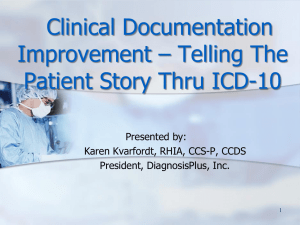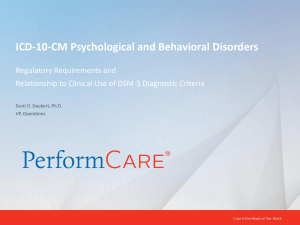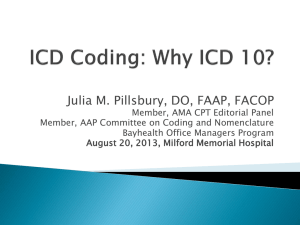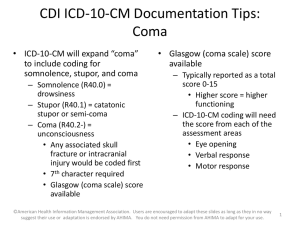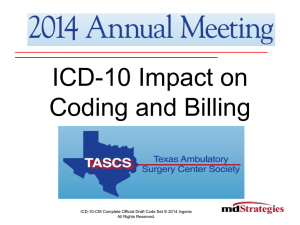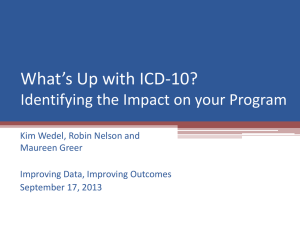Preparing for ICD-10
advertisement
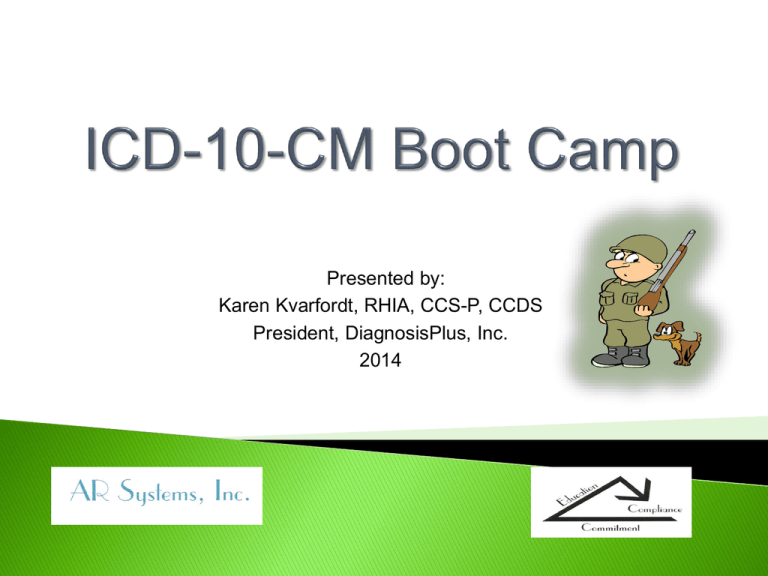
Presented by: Karen Kvarfordt, RHIA, CCS-P, CCDS President, DiagnosisPlus, Inc. 2014 It’s on our doorstep! The biggest change to happen in Health Information Management and the Revenue Cycle in more than 30 years! Preparation is the key. Will you be ready? 2 WHO (World Health Organization) owns & publishes ‘ICD’ (International Classification of Diseases). WHO endorsed ICD-10 in 1990; members began using ICD-10 or modifications in 1994. United States is the only industrialized country not using ICD-10 for our coding & reporting of diseases, illnesses, and injuries. Why? What makes us so different? 3 United Kingdom (1995) Denmark, Finland, Iceland, Norway, Sweden (1994 – 1997) France (1997) Australia (1998) Belgium (1999) Germany (2000) Canada (2001) U.S. (2015) (Reimbursement + Case Mix) 4 If it’s not broken, why fix it? 5 Bottom line…We have run out of space and cannot capture any new diseases and/or procedures. Does not capture ‘specificity’ as ICD-10 does. In 1979, the year ICD-9 was implemented, the Nobel Prize was awarded for the CT scanner. Just think about how far we have come in healthcare since then, while our codes have remained in ICD-9! 6 We all know that ICD-10 will impact the coder, but who else? 7 Scheduling – Pre-certs, eligibility ◦ Don’t forget Medicaid! Medical Necessity CPT Codes – software, manual processes, cheat sheets Recurring Accounts – Will need new pre-certs & re-coded after October 1, 2015 Payer Acceptance of new ICD-10 codes PLUS ICD-9 codes – 2 batches Payer Contract Language – Dx codes Payer Remark Codes/Denial Codes CDM – Hardcoded RT/LT needs to match with the soft coded RT/LT ICD-10 diagnosis code Trauma Registry – Translation of codes All IT Systems Within The Organization Decision Support & Utilization Patterns – Will need to be translated Revise Forms To Include New ICD-10 Codes ◦ Lab Requisitions ◦ Physician encounter forms ◦ EMR ◦ CPOE 8 UB submissions with ICD-9 and ICD-10 - conversion dates Denials with new reasons – as ICD-10 is far more specific Contract language that addresses ICD-10 inclusions/exclusions Claim scrubbers/payer scrubbers – ABN issues (LCD/NDC dx codes), ‘if’ rules, edits Pre-authorization process/coverage WC and Liability are not subject to HIPAA standard transactions. Will they convert? What does this really mean? 9 Physician dictates ► hospital coders code ► UB is created. New! Why not share the codes with the providers who are attached to the account? Why repeat the same coding process in the physician office? New! Brown bag coding luncheons with the provider offices. Office brings samples to code, hospital coders code while teaching ICD-10 concepts. New! Hospital becomes the outsourcing company to assist small practices with coding. 10 So…what is ICD-10? 11 Department of Health and Human Services (HHS) mandated that HIPAA covered entities must update medical coding sets, effective October 1, 2015 (1 year delay). Diagnosis code set changes from ICD-9-CM to ICD-10-CM. Hospital inpatient procedure code set changes from ICD-9-CM (Volume 3) to ICD-10-PCS. No impact on CPT and/or HCPCS codes. Yeah! We will still report CPT codes for all outpatient procedures/services & physician hospital visits to Observation and Inpatients (E&Ms). 12 ICD-10-CM (Diagnoses) ◦ Will be used by all hospitals, providers, clinics, lab, radiology, psych, rehab, nursing homes, etc. ICD-10-PCS (Procedures) ◦ Will be used only for hospital claims for inpatient hospital procedures CPT/HCPCS – No change! ◦ Procedures for Hospital Outpatients, Physician Visits, Lab and Radiology Outpatients, etc. 13 October 1, 2015 – Compliance date for implementation of ICD-10-CM (diagnoses) and ICD-10-PCS (inpatient procedures). CMS initially stated that there would be no grace period. Then why the 1 year delay? And now another year? 14 CMS clarified policy for processing split claims for hospital encounters that span the ICD-10 implementation date. ◦ MLN (Medical Learning Network) Matters Number: SE1325 Split Claims ◦ Require providers split the claim so all ICD-9 codes remain on one claim with Date of Service (DOS) through September 30, 2015, and all ICD-10 codes placed on the other claim with DOS beginning October 1, 2015 and later. ◦ Same guidance for Inpatient and Outpatient encounters! 15 Diagnosis Coding (ICD-10-CM) 16 ICD-9-CM ◦ 3 - 5 digits or characters ◦ 1st character is numeric or alpha (E or V codes) ◦ 2nd – 5th characters are numeric ◦ Decimal placed after the first 3 characters ◦ 17 Chapters and “V” & “E” codes are ‘supplemental’ ◦ 14,000 diagnosis codes ICD-10-CM ◦ 3 - 7 digits or characters ◦ 1st character is alpha (all letters used except “U”) ◦ 2nd – 7th characters can be alpha and/or numeric ◦ Decimal placed after the first 3 characters (the same!) ◦ 21 Chapters and “V” & “E” codes are ‘not’ supplemental ◦ 69,000+ diagnosis codes 17 X X X X X X X Category Etiology, anatomic site, severity Extension 18 Provides many, many more categories for diseases and other health-related conditions Higher level of “specificity” Combined etiology and manifestations, poisoning and external causes, or diagnosis and symptoms into a single code Did you know that ICD-11 is already in draft format? 19 Greater “specificity and detail” in all diagnosis codes! ◦ But…is there supporting physician documentation in the medical record? 34,250 (50%) of all ICD-10-CM codes are related to the musculoskeletal system 17,045 (25%) of all ICD-10-CM codes are related to fractures ◦ 10,582 fracture codes will distinguish ‘right’ vs. ‘left’ 25,000 (36%) of all ICD-10-CM diagnosis codes will now distinguish right vs. left 20 ICD-9-CM (Irregular Astigmatism) (367.22) ◦ Only 1 code in ICD-9-CM ICD-10-CM (Irregular Astigmatism) ◦ Will have 4 code choices: H52.211 (Irregular astigmatism, right eye) H52.212 (Irregular astigmatism, left eye) H52.213 (Irregular astigmatism, bilateral) H52.219 (Irregular astigmatism, unspecified eye) Physicians are likely documenting “laterality” now, but coders aren’t looking for it. ◦ One easy place to look for documentation improvement! 21 Combination codes for conditions and common symptoms or manifestations E10.21 Type 1 diabetes mellitus with diabetic nephropathy Added laterality (left vs. right) M94.211 Chrondromalacia, right shoulder Added 7th character extensions for episode of care S06.01xA Concussion with loss of consciousness of 30 minutes or less, initial encounter Expanded codes (injuries, diabetes, alcohol & substance abuse, postoperative complications) F14.221 Cocaine dependence with intoxication delirium 22 Injuries are grouped by anatomical site rather than by the type of injury Diseases of the sense organs (eyes & ears) have their own chapters, no longer part of the Nervous System chapter Inclusion of trimesters in obstetric codes and elimination of 5th digits for episode of care O99.013 Anemia complicating pregnancy, third trimester Change in timeframes specified in certain codes Acute myocardial infarction – time period changed from 8 weeks to 4 weeks Full code titles for all codes (no reference back to common fourth and fifth digits) Post-op complications have been moved to procedurespecific body system chapters 23 We tend to focus on the ways ICD-10-CM is different, such as: Number of codes (69,000+) Length of the codes The “look” of the codes Level of specificity Increased documentation requirements But wait! The indexes will be structured very much the same as in ICD-9-CM. 24 Two main parts: Alphabetic Index & Tabular List Alphabetic Index ◦ Alphabetical list of terms and their corresponding codes ◦ Index to Diseases and Injury Neoplasm Table Table of Drugs and Chemicals ◦ Index to External Causes of Injury Coding Tip: The “-” at the end of an index entry indicates that additional characters are required – need to look further! 25 Chronological list of codes divided into chapters (21) based on body system and/or condition. Further divided into categories and subcategories which may be either letters or numbers. For some chapters, the body or organ system is the axis of the classification. Diseases/conditions of the sense organs (eyes and ears) have been separated from the Nervous System diseases/conditions and have their own chapters in ICD10-CM. Certain diseases have been reclassified (or reassigned) to a more appropriate chapter in ICD-10-CM. 26 The final character in a code may be either a letter or a number. Utilizes dummy place holders, always letter “x”. ◦ Is not case-sensitive (upper/lower case) A dummy “x” is used as a 5th character place holder for certain 6 character codes to allow for future expansion. Certain categories have 7th character extensions (fractures/injuries/obstetrics). The extension is required for all codes within the category, or as the notes in the tabular instruct. 27 Found predominately in 2 chapters: ◦ Chapter 19 (Injury, Poisoning and Certain Other Consequences of External Causes) ◦ Chapter 15 (Pregnancy, Childbirth and the Puerperium) Injuries/Poisonings: ◦ Episode of Care: Designates the episode of care as initial, subsequent or sequela Pregnancy/Childbirth/Puerperium: ◦ Provides additional information about the fetus: Used to identify certain complications of pregnancy with multiple gestation to identify which fetus(es) is(are) affected by the condition indicated by the code. 28 ALL diagnoses within this category will require a 7th character (episode of care). Tabular list will identify which diagnosis codes will need this final character in the code. Provides a shaded box to let you know the applicable 7th characters for the code. Have to “build” the characters to get to the final spot in the code (7th character). 29 A Initial encounter D Subsequent encounter S Sequela (disease progression/late effect) Coders will need to look for the episode of care. Is this the patient’s 1st visit for treatment or is it for routine follow-up? Is it clearly documented in the medical record? 30 Period when a patient is receiving ‘active’ treatment for an injury, poisoning or other consequences of an external cause. “A” may be assigned on more than 1 claim. Patient is seen in the ER for a head injury that first is evaluated by the ER physician. If the ER physician requests a CT scan that is subsequently read by a radiologist and/or neurologist, the 7th character “A” for initial is used by all 3 physicians and also reported on the ER claim by the hospital. 31 Occurs after the active phase of treatment, when patient is receiving routine care during a period of healing or recovery. Examples of “subsequent” care: Cast change or removal External or internal fixation removal Medication adjustment Follow-up visits following fracture treatment 32 Today we code the ‘after care’ code as the principal diagnosis, i.e., V57.1 (physical therapy), etc. In ICD-10-CM we will have to report the acute injury code with the correct 7th character, i.e., “D”, etc. to identify that it is a ‘subsequent’ encounter. What is on your order today? Injury diagnosis or just order for PT? 33 Assigned for complications or conditions that arise as a direct result of an injury. ◦ Example: Scar resulting from a burn When using extension “S”, you will code both the injury that precipitated the sequela and the sequela itself. There is no time limit on when a sequela code can be used. ◦ Coding Tip! Sequence the specific type of sequela, i.e., scar first, followed by the injury code, i.e., burn as the secondary diagnosis. 34 Fracture Coding 35 Coders will need the following to code a fracture in ICD-10-CM: ◦ Displaced or non-displaced ◦ Open or closed ◦ Laterality (left vs. right vs. bilateral) ◦ Specific bone and location of the bone Distal, proximal, mid-shaft, etc. ◦ Encounter Initial, subsequent, sequela 36 Identifies if the fracture is open or closed for an initial encounter, or if a subsequent encounter is for routine healing, delayed healing, nonunion, malunion, and/or sequela. ◦ Fracture extensions: A B D G K P S (Initial encounter for closed fracture) (Initial encounter for open fracture) (Subsequent encounter for fx with routine healing) (Subsequent encounter for fx with delayed healing) (Subsequent encounter for fx with nonunion) (Subsequent encounter for fx with malunion) (Sequela) 37 Initial encounter for closed and open fractures ◦ Use while the patient is receiving “active” treatment for the fracture 7th Character Extensions: A ► Closed fracture B ► Open fracture type I (one) or II (two) or unspecified C ► Open fracture type III (three) Examples of “active” treatment: Surgical treatment Emergency Department encounter Evaluation & treatment by a new physician 38 Subsequent encounter for open and closed fractures: ◦ Used for encounters after active fracture treatment has been completed and the patient is receiving routine care during the healing or recovery period. Closed Fracture 7th Character Extensions: D ► Routine healing or aftercare G ► Delayed healing K ► Nonunion P ► Malunion 39 Gustilo-Anderson classification identifies the energy, soft-tissue damage, and the degree of contamination in “open” fractures – may be new to coders and orthopedic physicians. ◦ Type I: Wound is smaller than 1 cm, clean, and generally caused by a fracture fragment that pierces the skin (low energy injury) ◦ Type II: Wound is longer than 1 cm, not contaminated, and w/o major soft tissue damage or defect (low energy injury) ◦ Type III: Wound is longer than 1 cm, with significant soft tissue disruption. The mechanism often involves highenergy trauma, resulting in a severely unstable fracture with varying degrees of fragmentation. 40 Purpose of the fracture classification system in the clinical setting is to allow communication that infers fracture morphology and treatment parameters. Important to educate providers on the use of this scale for the specific documentation necessary in ICD-10-CM. Make sure to look at each 7th character box in the fracture section, as not all categories utilize the Gustilo classification because it is not for all bones or all types of fractures. 41 There are no combination codes for fractures involving both the radius and ulna in ICD-10-CM. Each fracture will be coded separately. 42 24 choices for fracture of clavicle (only 1 in ICD-9-CM) Documentation must include: ◦ Laterality ◦ Displaced (anterior or posterior displacements) ◦ Nondisplaced ◦ Location: sternal end, shaft, lateral end, unspecified ◦ 7th character extension ◦ Example: S42.011B (Anterior displaced fracture of sternal end of right clavicle initial encounter open fracture) 43 I10 Essential (primary) hypertension S01.02xA Laceration with foreign body of scalp, initial encounter S01.02xD Laceration with foreign body of scalp, subsequent encounter S02.2xxA Fracture of nasal bones, initial encounter for closed fracture H65.01 Acute serous otitis media, right ear H65.02 Acute serous otitis media, left ear H65.03 Acute serous otitis media, bilateral 44 On any given day, anything can happen! W17.82xA Fall from (out of) grocery cart, initial encounter V94.4xxA Injury to barefoot water-skier, initial encounter W61.43xA Pecked by turkey, initial encounter Y93.C2 Activity, handheld interactive electronic device, i.e., cellular phone 45 CMS has created GEMs (General Equivalence Mappings) to assist hospitals with cross walking ICD-9-CM ►ICD-10-CM/PCS “forward mapping” & ICD-10-CM/PCS ◄ ICD-9-CM “backward mapping”. The correlation between the 2 code sets for some codes is fairly close, but not a straight correlation for others, i.e. OB, etc. Not always 1 to 1 crosswalk from ICD-9-CM to ICD-10-CM (www.cms.gov/ICD10/11b15_2013_ICD10PCS.asp) Available on CMS’s website 46 ICD-9-CM Code Diagnosis ICD-10-CM Code V20.2 Routine infant or child examination Z00.129 (Encounter for routine child exam without abnormal findings). Z00.121 (Encounter for routine child exam with abnormal findings). “Use additional code(s) to identify abnormal findings”. 250.00 DM w/o complications, type II or unspecified E11.9 (Type II DM without complications) V04.81 Need for prophylactic vaccination and inoculation Z23 (Encounter for immunization). “At this time in ICD-10-CM there is only one code for immunizations”. 401.1 Hypertension, benign I10 (Essential [primary] hypertension). “ICD-10-CM does not differentiate between hypertension that is controlled or uncontrolled, benign or malignant and there is only one code”. 427.31 Atrial fibrillation I48.0 (Atrial fibrillation) I48.1 (Atrial flutter) 786.50 Chest pain, unspecified R07.0 (Chest pain, unspecified). “ICD-10-CM expands upon chest pain symptoms and unspecified code may no longer be necessary”. 465.9 URI J06.9 (Acute upper respiratory infection, unspecified) 724.2 Lumbago M54.5 (Low back pain) 466.0 Bronchitis, acute J20.0 (Acute bronchitis, unspecified). “ICD-10-CM includes 10 choices for acute bronchitis”. 729.5 Limb pain M79.604 (Pain in right leg) 47 ICD-10-CM Code Structure 48 1st character is always an alphabetic letter. All the letters of the alphabet are used except for the letter “U” which has been reserved for the provisional assignment of new diseases & uncertain etiology (U00-U49) & for bacterial agents resistant to antibiotics (U80-U89). ICD-10-CM codes may consist of up to seven characters, with the 7th character extensions representing ‘visit’ encounter or sequela for injuries and external causes. 49 X X X X X X X Category Etiology, anatomic site, severity Extension 50 Laterality: left vs. right vs. bilateral For bilateral sites, the final character of the codes in ICD-10-CM indicate laterality. Right side is always character 1 (RT) Left side is always character 2 (LT) Bilateral code is always character 3 (RT & LT) But wait! Not all codes will have a ‘bilateral’ distinction, i.e., carpal tunnel, etc. “Unspecified” side code is also provided should the side not be documented in the medical record. Did we just lose our specificity? 51 Providers will need to document which side, left or right, that the injury or diagnosis has occurred for over 25,000 + codes. ◦ H60.332 – Swimmer’s ear, left ear ◦ M94.211 – Chrondromalacia, right shoulder Coders should always assign the detailed codes, not the ‘unspecified’ codes that are also in ICD-10-CM, but to do that, the physician has to document it in the medical record. What do they document today? 52 Joint pain Joint effusion Injury Fractures Start working with your physicians Dislocations now to get them in the habit of Arthritis documenting laterality! Cerebral infarction Extremity atherosclerosis Pressure ulcers Cancers, neoplasms (breast, lung, bones, etc.) 53 Rather than reporting codes according to the episode of care, coders will report pregnancy codes by trimester in ICD-10-CM. ICD-9-CM: Pregnancy codes are defined by the ‘episode of care’ Unspecified Delivered Antepartum 54 Under ICD-10-CM diagnosis codes will be based on the “stage” of pregnancy: 1st trimester 2nd trimester 3rd trimester Trimesters are counted from the first day of the last menstrual period, and defined as: First trimester: Fewer than 14 weeks Second trimester: Fourteen weeks Third trimester: Twenty-eight weeks 55 Time frame for differentiating the abortion and fetal death codes has changed from 22 ►20 weeks Time frame for differentiating early and late vomiting in pregnancy will now change from 22 ►20 weeks Pre-term labor is defined as before 37 weeks of gestation (more defined definition) And…7th character extension to identify the fetus in multiple gestation: 0 – Not applicable or unspecified 1 – Fetus 1 2 – Fetus 2 3 – Fetus 3 4 – Fetus 4 5 – Fetus 5 9 – Other fetus 56 Terms “fetus” and “newborn” used in many of the ICD-9-CM code titles have been removed in many of the ICD-10-CM code descriptors. ◦ Single liveborn infant (Z38.00) Additionally, newborns affected by maternal factors and by complications of pregnancy, labor & delivery, the phrase “suspected to be” is included in the code title. ◦ P00.4 Newborn (suspected to be) affected by maternal nutritional disorders ◦ P00.5 Newborn (suspected to be) affected by maternal injury 57 Need to specify when intermittent attacks vs. persistent manifestations Document the Severity (3 levels): 1. Mild (more than two times per week) 2. Moderate (daily and may restrict physical activity) 3. Severe (throughout the day with frequent severe attacks limiting the ability to breathe) Clarification as to whether intrinsic or extrinsic Exercise-induced or other forms Specify when chronic state asthmatic bronchitis exists and when “acute exacerbation” occurs Differentiate from bronchiolitis (RSV?) and aspiration Document tobacco exposure or history of 58 Diabetes mellitus codes are expanded to include the classification of the diabetes and the manifestation by using 4th or 5th characters. ◦ Moving from 1 category of “250” ► 5 categories in ICD-10! ◦ ICD-9-CM = 59 diagnosis codes ◦ ICD-10-CM = 200+ diagnosis codes! Whether or not diabetes is stated as ‘controlled’ or ‘uncontrolled’ is not a factor in ICD-10. E10.11 Type 1 diabetes mellitus with ketoacidosis with coma E11.41 Type 2 diabetes with diabetic mononeuropathy E09.52 Drug or chemical induced diabetes mellitus with diabetic peripheral angiopathy with gangrene 59 Documentation needs to distinguish when due to intake of excessive calories vs. other causes Identify when morbid obesity exists Identify when obesity hypoventilation syndrome exists Identify when patient is overweight if it impacts patient care Diagnosis of obesity or overweight MUST be documented by the physician Coding of the patient’s BMI, however, can be taken from nurses or dietician’s notes 60 Assign the code(s) for the following diagnosis: Morbid obesity with a BMI of 42 in an adult E66.01 Z68.41 Morbid (severe) obesity due to excess calories Body mass index (BMI) 40.0 – 44.9. adult ◦ Tip! In the Tabular, the subcategory is Obesity due to excess calories. This is the correct code even though it is not documented that excess calories caused the obesity. This is the “default” code. ◦ Note at category E66 indicates that an additional code should be assigned for the BMI when known. 61 ICD-10-CM provides 50 different codes for “complications of foreign body accidently left in body following a procedure”, compared to only one code in ICD-9-CM. ◦ T81.535 – Perforation due to foreign body accidently left in body following heart catheterization ◦ T81.524 – Obstruction due to foreign body accidently left in body following endoscopic examination ◦ T81.516 – Adhesions due to foreign body accidently left in body following aspiration, puncture or other catheterization 62 ICD-10-CM in the Tabular List states: ◦ I10 Essential (primary) hypertension ◦ Includes: High blood pressure ◦ Hypertension (arterial) (benign) (essential) (malignant) (primary) (systemic) ◦ Excludes1: Hypertensive disease complicating pregnancy, childbirth and the puerperium ◦ Excludes2: Essential (primary) hypertension involving vessels of brain, essential (primary) hypertension involving vessels of eye No longer matters whether hypertension is malignant or benign in ICD-10-CM! 63 ICD-10-CM contains a separate category (F17) for nicotine dependence with further subcategories to identify the specific tobacco product and nicotine induced disorder. Some examples: Cigarettes Chewing tobacco Cigar, etc. ICD-9 has only one diagnosis code 305.1! 64 In Chapter 11 (Diseases of the Digestive System K00-K94) some terminology changes have occurred. The term “hemorrhage” is used when referring to ulcers, and the term “bleeding” is used when classifying gastritis, duodenitis, diverticulosis and diverticulitis. K25.0 Acute gastric ulcer with hemorrhage K29.01 Acute gastritis with bleeding K57.31 Diverticulosis of large intestine without perforation or abscess with bleeding 65 While ICD-9-CM did add a subcategory for pressure ulcer stages in 2008, two codes are required to code this specificity today but… ICD-10-CM provides the site (including laterality) and the stage all in one code (combination code)! ◦ Let’s code one! Find the diagnosis code for a pressure ulcer, Stage 2, left ankle L89.5- What diagnosis code did you come up with? 66 Code category T20-T32 classifies burns and corrosions in ICD-10-CM. Burn codes identify: ◦ Thermal burns, except for sunburns, that come from a heat source. ◦ Also burns resulting from electricity and/or radiation. Addition of the term “corrosion” is new in ICD-10-CM. ◦ Corrosions are burns due to chemicals. 67 “Underdosing” will be a new term to us in ICD-10-CM and is defined as taking less of a medication that is prescribed by a physician and/or manufacturer’s instructions with a resulting negative health consequence. Financial Reasons (#1) Patient Non-Compliance 68 ICD-10-CM Conventions 69 Many, but not all, of the ICD-10-CM conventions are similar to the ICD-9-CM conventions. Similar to ICD-9-CM, abbreviations, punctuation, symbols and notes are used as conventions and have special meanings that affect the code assignment. ◦ NEC (Not Elsewhere Classified) – “other” types of conditions H26.8 Other specified cataract ◦ NOS (Not Otherwise Specified) – used when the documentation of the condition by the provider is insufficient to assign a more specific code J12.9 Viral pneumonia, unspecified Notice anything familiar? 70 ICD-9-CM uses “Includes” and “Excludes” notes ◦ Includes: Good indication your in the right place ◦ Excludes: Better keep looking because you’re in the wrong place ICD-10-CM will use: Excludes1 Excludes2 71 Excludes1 note (pure Exclude) indicates ‘not coded here’. The code being excluded is never used with the first listed code. The two conditions cannot occur together. ◦ Example: B06 Rubella [German Measles] has an Excludes1 of congenital rubella, P35.0 Exlcudes2 note indicates ‘not included here’. The excluded condition is not in this section of codes, so you will have to look elsewhere in the book to code that specific condition. 72 Includes Excludes Notes Excludes1 Excludes2 Code First/Use Additional Code Code Also 7th characters (extensions) *new* Placeholder “x” *new* 73 Dummy placeholder which is always the letter “x” and is not ‘case sensitive’ When “x” is in the 5th or 6th character, the “x” is called a placeholder When “X” (upper case) is at the beginning of a code, it represents a specific “chapter” Coders will need to add a placeholder so the 7th character ends up in the correct position, otherwise, the code will be invalid S01.02xA Laceration with foreign body of scalp, initial encounter 74 ICD-10-CM Coding Guidelines 75 General coding guidelines for ICD-10-CM are similar to ICD-9-CM counterparts with one additional “new” guideline – laterality The laterality guideline states “For bilateral sites, the final character of the codes in ICD-10 indicates laterality” An “unspecified” side code is also provided should the side not be identified in the record If no bilateral code is provided and the condition is bilateral, assign separate codes for both the left & right side 76 Chapter 6: Diseases of Nervous System and Sense Organs (G00-G99) ◦ Dominant vs. Non-Dominant side Medical record documentation must identify whether the dominant or non-dominant side is affected. Should the affected side be documented, but not specified as dominant or non-dominant, code selection should be: If the left side is affected, the “default” is non-dominant. If the right side is affected, the “default” is dominant. 77 Chapter 16: Certain Conditions Originating in the Perinatal Period (P00-P96) “New” notes that help clarify how codes are to be used. ◦ Following note appears under P07: When both birth weight and gestational age of the newborn are available, both should be coded with birth weight sequenced before gestational age. Additional note: Codes from this chapter are only for use on the newborn or infant record, never on the mother’s record. 78 Currently in ICD-9-CM, if a patient is admitted for complications due to the malignancy, the complication, i.e., anemia, is the principal diagnosis. In ICD-10-CM, if the patient is admitted for anemia associated with malignancy and the treatment is only for the anemia, the appropriate code for the malignancy is sequenced as the principal diagnosis followed by code D63.0 (anemia in neoplastic disease) as a secondary diagnosis. Note! Docs will need to document whether the anemia is associated with the neoplasm or an adverse effect of the treatment associated with the malignancy. 79 Let’s Take a Sneak Peek At Procedure Coding In ICD-10! (ICD-10-PCS) 80 Only reported on “inpatient” hospital procedures. Every procedure will be 7 characters (alphanumeric) with no decimal point. Letters “I” and “O” are never used in the actual procedure code. 3,000 ►71,920 procedure codes! 81 1 2 3 4 Root Operation Section 5 6 Approach Body Body System Part 7 Qualifier Device 82 Endoscopic Esophageal Excision via Natural or Artificial Opening ICD-9: 45.16 Esophagogastroduodenoscopy (EGD) with Closed Biopsy 0 D B 5 8 Z X Section (Medical/Surgical) Body System (Gastro-intestinal) Root Operation (Excision) Body Part (Esophagus) Approach (Via natural or artificial opening endoscopic) Device (No Device) Qualifier (Diagnostic) 83 Physician Documentation 84 ICD-10 impacts physician documentation in both the office and hospital settings. Many physicians consider additional documentation requirements to be an unnecessary burden imposed by the mandated federal requirement of transitioning to ICD-10. But what will they really need to further document? 85 Documentation requirements will vary greatly by specialty. For example, ICD-10-CM codes related to ophthalmology have changed little in scope whereas diagnosis codes related to the musculoskeletal system have increased dramatically. Only focus on those diagnosis codes that your hospital and/or physician practice utilizes. Note: The sheer # of codes in ICD-10-CM results in the code book that is over 1,100 pages with very small print! 86 1. 2. 3. 4. 5. 6. 7. 8. 9. 10. Laterality (left vs. right) 25,000+ codes! Stage/Episode of Care (initial, subsequent & sequela) Stage of Disease (acute vs. chronic, severity of pressure ulcer) Specific Anatomy (specific bone in the hand) Associated and/or Related Conditions (diabetes with manifestation) Cause of Injury (hit by baseball, fall) Additional Symptoms or Conditions Dominant vs. Non-Dominant Side Tobacco Exposure or Use Gustilo-Anderson Scale 87 “CC” = Complication and/or comorbidity “MCC” = Major complication and/or comorbidity CC List: ◦ 3,427 codes in the ICD-9-CM based version ◦ Replaced by 13,594 codes in the ICD-10-CM based version MCC List: ◦ 1,592 codes in the ICD-9-CM based version ◦ Replaced by 3,152 codes in the ICD-10-CM based version But does our medical record documentation support the coding of these diagnoses? 88 ICD-10-CM diagnosis codes will impact every physician office. Large or small! Look at all areas that will impact your practice and identify each one that will be affected: Practice Management System Electronic Medical Record (EMR) Paper record Lab requisitions Superbill/encounter form – Does it have diagnosis codes on it? 89 The use of the superbill as a way to capture or collect data for coding purposes probably will not be practical under ICD-10-CM. Example: Although there are 33 codes for fractures of the radius in ICD-9-CM, most orthopedic practices superbill generally include only 6 codes or less. Coding often ‘defaults’ to one of these codes, even though another of the other 33 codes might have been more accurate. Under ICD-10-CM there are 392 codes for fractures of the radius and there is simply not enough room to include these codes, + the thousands of other diagnosis codes on the superbill. 90 Although the coding book is “huge”, many physician practices use only a small set of diagnosis codes. Work with physicians to develop crosswalks between ICD-9-CM and ICD-10-CM codes they frequently use. Begin discussions now with office staff and physicians to reduce anxiety (hospital & physician offices = TEAM) In-depth training should occur at least 6 months prior to the ‘go-live’ date. Training should have both a general focus and then a practice-specific focus: ● Cardiology ● Oncology ● Orthopedic ● Internal Medicine ● General Surgery 91 AHIMA estimates approximately 16 hours of coding training is needed for outpatient coders and 50 hours for inpatient coders. Additional time may be needed to refresh anatomy & physiology fundamentals. Need to allow time for practice, practice, practice! 92 Type ICD 9/minutes ICD 10/minutes Inpt acute care 8.99 15.99 Outpt acute care 4.18 9.03 Physician practice 3.04 6.70 Free standing ASC 2.27 4.82 Nursing/SNF 6.71 12.98 Rehab facility 4.97 10.94 2 minutes additional for each encounter 30% estimated loss in productivity Additional time projected by CMS 93 AAPC (American Academy of Professional Coders) Certified coders will have opportunity to take the ICD-10 proficiency exam beginning October 1, 2012 and must successfully complete the exam by September 30, 2015. ** Currently being re-evaluated due to the 1 year delay** Must take and pass proficiency exam to maintain AAPC certification ► Online, timed, 75 questions, open book ► May use any resource available to complete ► $60 exam fee – includes ability to take the exam twice AHIMA (American Health Information Management Association) Continuing education hours with ICD-10-CM/PCS content will be required based on the specific AHIMA credential(s). RHIA/RHIT - Required to have @ least 6 CEUs CCS-P credential – 12 CEUs CCS credential – 18 CEUs And many others… 94 That’s ICD-10-CM! 95 Day Egusquiza, President daylee1@mindspring.com www.arsystemsdayegusquiza.com Karen Kvarfordt, RHIA, CCS-P, CCDS AHIMA Certified ICD-10 Trainer President, DiagnosisPlus, Inc. diagnosisplus1@live.com 96
